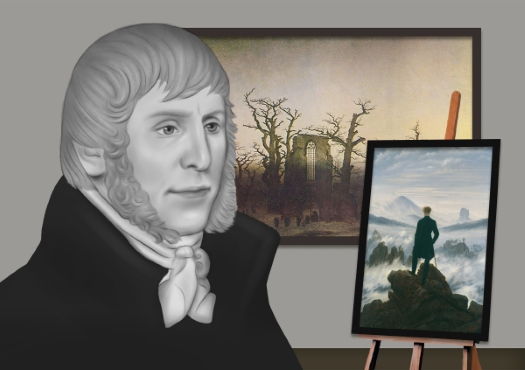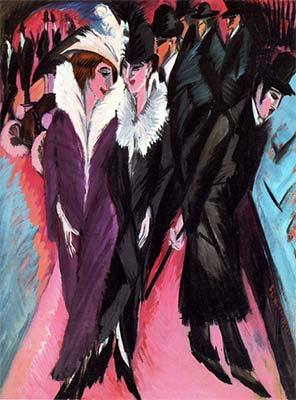Summary of Caspar David Friedrich
Seeking to capture an experience of the infinite, Caspar David Friedrich composed works that directly confronted the viewer with the awesome. Friedrich took the genre of landscape painting, traditionally considered unimportant, and infused it with deep religious and spiritual significance. Believing that the majesty of the natural world could only reflect the magnificence of God, he featured sunlight vistas and foggy expanses to convey the beautiful power of the divine.
Accomplishments
- Friedrich's moody landscapes, which often thrust the viewer into the wilds of nature, created an emotional connection with the viewer rather than a more literal interaction with the scene. This integration of spiritual significance with landscape painting made him a popular success.
- While conservative contemporaries challenged Friedrich's allegorical and religious landscapes, the artist maintained that his work never simply replicated a view, but rather provided opportunity to contemplate God's presence in the world. Using dramatic perspectives and misty, untamed expanses that dwarfed any figures, Friedrich encouraged the viewer to accept the awesome power of nature as evidence of a divine spirit.
- Dismissing the picturesque traditions of landscape painting, Friedrich embraced the Romantic notion of the sublime. Through his sensitive depictions of mist, fog, darkness, and light, the artist conveyed the infinite power and timelessness of the natural realm; the viewer is physically reminded of his frailty and insignificance.
- Friedrich's subtle color palette and emphasis on light often created an overwhelming sense of emptiness that would influence Modern Art. The visual minimalism of his paintings was so unusual that his audiences were often confused; reportedly, one group of art enthusiasts who visited his studio viewed a work upside down on the easel, believing the clouds were waves and the water was the sky. Modernists would learn from his use of subdued color and the simplicity of his compositions that still conveyed profound ideas.
The Life of Caspar David Friedrich
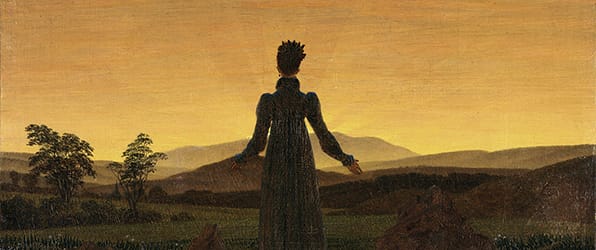
Reclusive artist Caspar David Friedrich all but lost himself in the immensity, fierceness, and awe-inspiring majesty of the natural landscapes of Germany, leading him to become one of the foremost painters of the Romantic era.
Important Art by Caspar David Friedrich
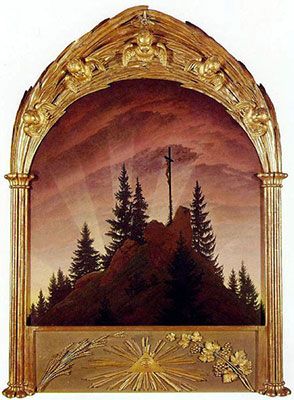
The Cross in the Mountains (The Tetschen Altar)
Commonly referred to as The Tetschen Altar, Friedrich's The Cross in the Mountains features a pine-covered mountaintop upon which stands a large crucifix. The cloud-filled sky is rendered in shades of red, pink, and violet which fade from dark to light from the top to the bottom of the canvas. Five beams of light emanate from a distant, unseen horizon.
The shaped canvas is set in an elaborate frame, designed by the artist but carved by his friend Gottlieb Christian Kuhn. The frame features a range of Christian symbols, including the heads of five baby angels, a star, grapes and vines, corn, and the eye of God.
This painting, one of his earliest, embodies many of the Romantic motifs and themes he would address throughout his career, most notably the important symbolism of the landscape itself. Indeed, although the altarpiece includes a crucifix, the emphasis is placed on the spiritual essence of nature. He described the work: "High up on the summit stands the cross, surrounded by evergreen fir trees, and evergreen ivy twines about the base of the cross. The glowing sun is sinking, and the Saviour on the cross shines in the crimson of the sunset ... The cross stands on a rock, as unshakably firm as our faith in Jesus Christ. Fir trees rise around the cross, evergreen and everlasting, like the hope of men in Him, the crucified Christ." This was a groundbreaking reinterpretation of the genre of landscape painting giving it a new level of potential significance. It reflected Friedrich's belief that the divinity of God could be best found in nature.
While Friedrich was deeply religious, aspiring to paint an image that would convey the power of God more fully than possible through words, his approach was highly controversial. When the artist opened his studio to the public in 1808, allowing them to view this work, the 19th-century art critic Wilhelm von Ramdohr argued that a landscape could not function as an altarpiece. Friedrich and his supporters publicly defended the painting and the resulting debate helped to build Friedrich's reputation.
Oil on canvas - Collection of Gemaldegalerie Neue Meister, Dresden, Germany
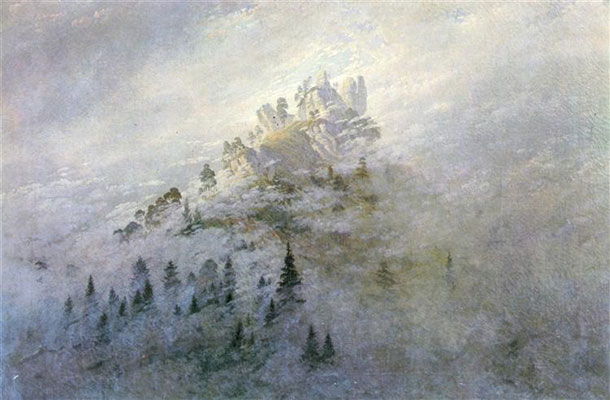
Morning Mist in the Mountains
This simple painting of a mountain peak awash in a white mist of early dawn fog, surrounded by barely discernable pine trees and rocky outcroppings manifests Friedrich's ideals of the Romantic landscape. This majestic, remote view of monumental nature implied a connection to a higher power, particularly in its scale and use of light. Here, a break in the clouds allows light to shine through, as if illuminating the mountain peak with a divine light.
To achieve this religious message, the depiction of mist was an important symbol for the artist. As he explained, "When a landscape is covered in fog, it appears larger, more sublime, and heightens the strength of the imagination and excites expectation, rather like a veiled woman. The eye and fantasy feel themselves more attracted to the hazy distance than to that which lies near and distant before us." Positioning us before this vast expanse with no sense of foreground, he wanted to immerse the viewer in the experience of the natural realm; a dramatic field that he felt most closely expressed the beauty and power of God. This approach created a new possibility for religious painting, based not in overt Christian symbolism, but in direct contact with awesome beyond the control of man.
Oil on canvas - Collection of Thuringer Landesmuseum Heidecksburg, Rudolstadt, Germany
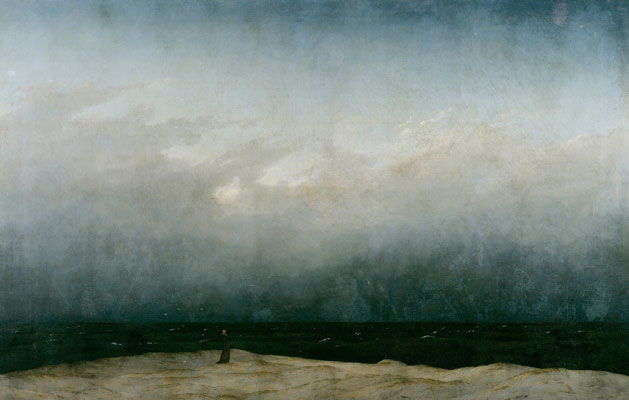
The Monk by the Sea
Arguably one of Friedrich's most important and well-known works in his oeuvre, this painting launched the artist to international fame when it was exhibited with The Abbey in the Oak Woods (1808-10) at an 1810 art exhibition in Berlin. A vast, empty landscape is dominated by the top three quarters of the canvas, which depicts a blue-gray sky and green sea. The foreground is an uneven swath of beige land where, just left of center, stands a man. Although his back is to the viewer, he is identifiable by the long, dark robe of a monk. The canvas is filled with large expanses of color, punctuated by small brushstrokes of white to denote a few crests of waves and birds in the sky. It is a masterpiece of minimalism and pictorial restraint, while still conjuring a felt sensation of awe, wonder, and humility.
The positive reception of this pair of paintings contributed to Friedrich' election as a member of the Berlin Academy and also drew the favor of Prince Friedrich Wilhelm Ludwig of Prussia, who purchased the two exhibited paintings for the royal collection; a prestigious honor. Beyond the accolades, however, this work demonstrates Friedrich's experimental spirit. Any traditional approach to landscape painting has disappeared. At a quick glance, the compositional structure appears uneven and lacks a perspective focal point. Rather than illustrate a scene, Friedrich has created an opportunity for the viewer to experience a range of emotions, only suggested by the artist. If he had included more details, the viewer would be tempted to invent a narrative or story, but with this bare minimum, we are felt with only sensorial information.
This new way of creating landscapes reinforced the idea that the viewer should contemplate the sublimity of the natural world and read into it an expression of the spiritual. The potential for deep meaning in a sparse, non-narrative style, would be critical to modernist abstraction. This painting, in particular, has been linked with the post World War II Color Field paintings of Mark Rothko, also intended to cultivate a spiritual experience for the viewer.
While Friedrich often painted landscapes without a human presence, this painting represents his second approach to investing the landscape painting with a deeper significance and connection to the viewer: the use of a proxy or stand-in. The solitary figure turned towards and in communion with the landscape, known as "ruckenfigur," is one of the key ways German Romanticism differentiates itself from French and British Romanticism. Although internationally, Romanticism was occupied with the connection between man and nature, British painters tended to emphasize more nostalgic or bucolic landscapes, while the French painters often suggested man's desire to conquer nature; the German approach depicts man's attempt to understand nature and, by extension, the divine. This preference for an emotional connection between the viewer and the image replaced more literal or illustrative approaches, exemplified by Friedrich's moody landscapes, which often thrust the viewer into the wilds of nature.
Oil on canvas - Collection of Nationalgalerie, Stattliche Museen zu Berlin, Germany
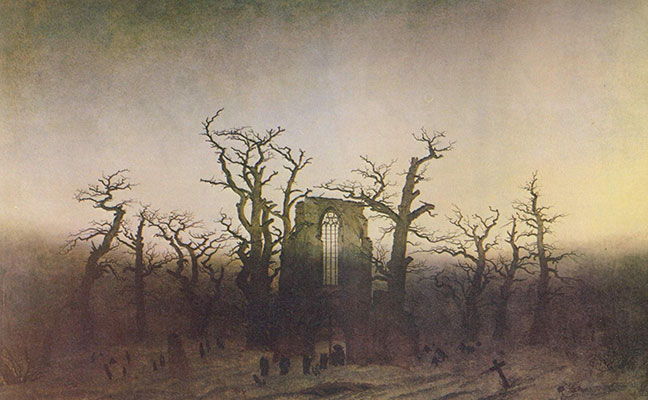
The Abbey in the Oak Wood
A study in subtle colors, rendered in soft shades of browns, yellows, and white, this painting depicts the crumbling remains of a Gothic abbey set amongst a field of barren leafless trees. The outlines of cross markers and tombstones are scattered around the remaining wall of the abbey entrance with its tall thin window. The bare outline of a few monks can be seen about to pass through what remains of the church's entrance, perhaps making a pilgrimage to mourn the dead.
Friedrich often included traces of Gothic architecture, here in the form of the abbey ruins, in his works. This reflects a nationalistic pride in the monuments of the German Gothic past that were particularly significant during the years of Napoleonic occupation. The Gothic was also a period that imbued spiritual significance into a range of artistic production. 20th-century German Expressionists would also look back to the Gothic as a source of national and religious strength.
Additionally, this painting shows Friedrich's masterful use of negative space and absence to create a sense of loss and longing. The depiction of ruins and the barren trees suggest death and abandonment, compounded by the dull, muted color palette and uneven compositional balance. Like his The Monk by the Sea, the majority of the canvas depicts only empty sky. Yet the message is not nihilistic: soft light suggests the sun shines down through the clouds; the oak trees are barren, but not dead. There is a promise of rebirth and resurrection.
Oil on canvas - Collection of Nationalgalerie, Stattliche Museen zu Berlin, Germany
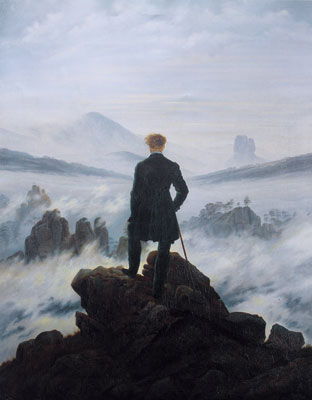
Wanderer above a Sea of Fog
Wanderer above a Sea of Fog (sometimes also referred to as "Sea of Mist") depicts a lone man, formally dressed and holding a walking cane, standing on an outcropping of rocks looking out at an inhospitable expanse. He stands perfectly still, only his hair ruffled by an unseen wind, against a tumultuous field that churns at his feet. In the background is a sky filled with white puffy clouds and the outline of mountaintops barely visible through the mist. As the man contemplates the vastness before him, the sublimity of nature is demonstrated not in a calm, serene view, but in the sheer power of what natural forces can accomplish.
Friedrich is known to have made political statements in his painting, often coded in subtle ways. The costume the figure wears was worn by students and others during Germany's Wars of Liberation; by the time of this painting, the clothing was forbidden by Germany's new ruling government. By deliberately depicting the figure in this outfit, he made a visual, albeit understated, stand against the current government. The political nature of this work did not stop there however; his work (especially this painting) were adopted and abused by the Nazi regime as symbols of intense German nationalism. Because Friedrich replaced more literal illustration with merely suggestive messaging, his paintings were easily reinterpreted to fit new political intentions. It would take more than three decades, into the 1980s, for his work to be viewed and appreciated once again without the taint of Nazism.
Oil on canvas - Collection of Kunsthalle Hamburg, Hamburg, Germany
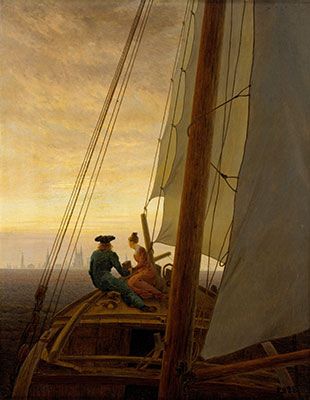
On the Sailing Boat
Caspar David Friedrich's On the Sailing Boat features the bow of a ship heading towards the horizon. Two figures, a man in a blue suit and hat and a woman in a pink dress with white lace collar, hold hands while looking at what lays ahead. The right side of the canvas is consumed by a closely focused depiction of the sail and the boat's mast. In the distance, the viewer can discern the faint outline of buildings, silhouetted in mist. The largest expanse of the canvas is occupied by a glowing yellow sky.
A departure from his usual landscape formula, with its implied narrative and more traditional use of symbolism, this work creates a connection between the painting's viewer and the scene. We are a passenger on the ship, a witness to the intrepid couple on their journey. This painting was made one year after Friedrich's marriage to Caroline Bommer and shows his transition from lone figures to the occasional depiction of a pair. Often, these female figures were based on his wife's image; in this painting the couple depicted are believed to be portraits of the artist and his wife. Rich in symbolism, their joined hands reference their new, happy union and their presence on a moving ship a metaphor for the new life they are embarking on.
Despite this conventional symbolism, Friedrich's approach to composition remains quite experimental, particularly in his use of an unbalanced composition. The verticality of the ship and the horizontality of the horizon are not arranged with traditional proportions, and the sharply foreshortened presentation of the ship broke with the contemporary expectations for composing a picturesque landscape.
Oil on canvas - Collection of Hermitage Museum, St. Petersburg, Russia
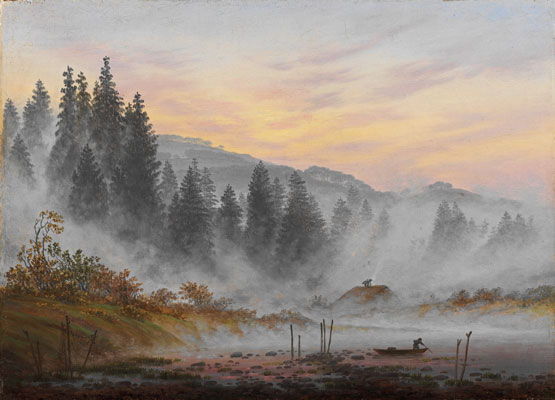
Morning
A small work measuring only 8 ? x 12 inches, Morning was intended to be part of a cycle of the times of day. It is a scene of quiet stillness that evokes the early morning. The mist lies low, wrapping around the pine trees in the midground, but beyond the sun rises above the distant mountains. In the foreground, a lone figure rows a boat, perhaps setting out from the small house whose roof is just visible about the fog. The sky is awash in the colors cast by the rising sun: yellow, orange, violet, and soft pinks.
Although Friedrich carefully depicted the sensations of the natural world, his paintings were created in the studio, based on simple sketches done in nature. They are imagined compositions, in which Friedrich manipulated elements for dramatic or symbolic emphasis. Later, as he became increasingly isolated and depressed, landscapes such as this also allowed him to contemplate life and its end. This is confirmed in his writings on this series in which he states, "Today for the first time the normally so glorious countryside cries out to me of decay and death, where before it has only smiled to me of joy and life. The sky is overcast and stormy, and today it casts its monochrome winter coat over the lovely colored mountains and fields for the first time. All nature lies before me drained of color."
Along with the writings that reveal his state of mind as he worked on these paintings, the decision to create these works as a cycle supports them being viewed as a visual expression of the examination of life from beginning to end (or morning to evening). A poetic expression on life, they are the visual representation of the Romantic view of life, death, and the divine.
Oil on canvas - Collection of Lower Saxony State Museum, Hanover, Germany
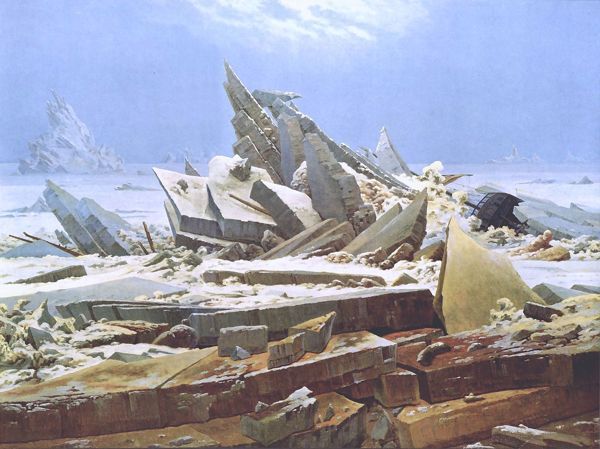
The Sea of Ice
Set against a vivid blue sky, the focal point of the painting is the wreckage of a ship that has crashed into the ice and the rocks of the shore. On the right of the canvas, a small portion of a ship's hull is visible rising out from broken chunks of ice.
The symbolism of this painting has been interpreted on political, autobiographical, and spiritual levels. Certainly, this scene of devastation suggests a deeper meaning; the work is not associated with any historical or literary source. Some have viewed it politically as a statement against the German government. According to the scholar Norbert Wolf, "The sailing ship being slowly crushed by pack of ice in a polar landscape otherwise devoid of signs of human life may be understood as a pathos-laden metaphor for a catastrophe on an epochal scale, whereby visually coded references to ruin and nevertheless to hope, to destruction and to regeneration, combine into a symbolic protest against the oppressive 'political winter' gripping Germany under Metternich."
Other scholars have read autobiographical interpretations into the painting that reference the loss of the artist's beloved brother in a childhood accident. Friedrich himself had fallen through some ice and his brother died trying to save him. We know that, in his later years, Friedrich often used his paintings to reflect of questions of loss and mortality, coming to terms with the tragedies of his childhood.
Universally, the destruction of the man-made vessel at the hands of powerful and unforgiving nature fits with Friedrich's admiration and awe of the natural world. In this inhospitable realm of frozen seas, man's audacity and self-confidence are dashed like children's toys by the immense force of the ice. We are dwarfed by the powers beyond our control.
This painting was not easily understood or appreciated when it was first created. It did not comply with either the expectations that such a scene of destruction should be rendered picturesque or else overtly moralized. Many contemporaries failed to understand the work and one critic wrote, "If only the ice painting of the North Pole would melt once and for all."
Oil on canvas - Collection of Kunsthalle Hamburg, Hamburg, Germany
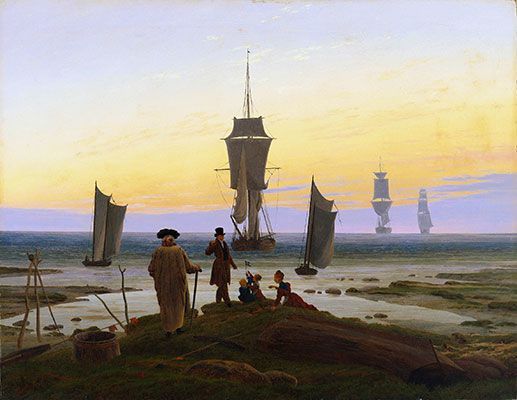
The Stages of Life
In The Stages of Life, five ships are at sea, moving toward a distant horizon. They are mirrored by five figures depicted on the grassy shore in the foreground: two small children, a boy and a girl, are watched by a young woman while a middle-aged man turns back from the water to address an elderly man in a long formal coat, hat, and cane. Dating from the later years of Friedrich's life, when the artist had withdrawn into near solitude, scholars have argued that the elderly man is a self-portrait and the others represent Friedrich's nephew and his three children.
This painting is one of the artist's last works before multiple strokes prevented him from working in oils. An allegory on the passing of time and the journey of life, the various stages of life are echoed in the five ships that move from the shore (start, birth) to the horizon (death, infinity), as well as in time as depicted from childhood to old age. As was common in Friedrich's painting, the sky dominates a majority of the canvas, changing from shades of blue to a wide wash of orange and yellow in the center, placing the time of day as early evening. As the sun sets and the ships move out to sea, there is a sense of peace, completeness, and acceptance.
Oil on canvas - Collection of Museum der bildenden Kunste, Leipzig, Germany
Biography of Caspar David Friedrich
Childhood and Education
The sixth of ten children, Caspar David Friedrich was born into a strict Lutheran family. He became familiar with tragedy at an early age, losing his mother when he was seven, and two sisters to childhood illnesses. Perhaps the most impactful loss was the death of his brother, Johann, who drowned while trying to rescue the then thirteen-year-old artist when he fell through the ice.
Educated by tutors, Friedrich began taking drawing lessons in 1790 from university professor Johann Gottfried Quistorp. His early interest in art was encouraged and at the age of twenty, he enrolled at the Copenhagen Academy. In addition to studying the masters, he developed his lifelong interest in nature and landscape. Importantly he also submersed himself in spiritual and mystical poetry that would serve to influence his later work and provide the foundation for his role as one of the leaders of German Romanticism.
Early Career
In 1798, the artist finished his studies and moved to Dresden, where his work found an admiring audience. From these earliest paintings, Friedrich espoused Romantic ideals, including the spiritual potential of art and the expression of religious sentiments through the power of nature. According to the artist, "man's absolute goal is not man, but the divine, the infinite. It is towards art, not the artist, that he should strive! Art is infinite, finite all artists' knowledge and ability." For Friedrich the landscape became the primary vehicle for rendering visual manifestations of the sublime, as can be seen in The Cross in the Mountains (1807-08) and Morning Mist in the Mountains (1808).
During these years of the Napoleonic Empire, Friedrich's investment in the landscape also carried political significance as he depicted typically German sites with a sense of pride and power practically beyond worldly limit. Until the fall of Napoleon in 1815, many of Friedrich's contemporaries interpreted his paintings through this lens of political self-determination and cultural heritage, believing they held the promise of future independence from foreign rule.
Mature Period
Quickly gaining recognition as one of the leaders of the Romanticism movement in Germany, Friedrich's 1816 election to the Dresden Academy resulted in a steady salary. This allowed for his 1818 marriage, at the age of forty-four, to Caroline Bommer with whom he would have three children; two daughters and a son. Despite his reputation as a solitary figure who had once stated, "in order not to hate people, I must avoid their company," the marriage had an immediate impact on his career. He began depicting his wife in some of his paintings, transforming his well-established motif of a lone figure immersed in the landscape to occasionally feature a couple.
Friedrich gained the attention and patronage of important international figures. The recognition he received when The Monk by the Sea (1808-10) and Abbey in an Oak Forest (1809-10) were exhibited at the Berlin Academy brought him into the path of Prince Friedrich Wilhelm Ludwig of Prussia who bought the two paintings. The ruling family would continue to support the artist until his liberal political views caused him to fall out of favor. His art was also well received in Russia as Tsar Nicholas I purchased some of his works for his court. In 1830, Prince Alexander of Russia commissioned the artist to make a series of transparent pictures (now lost) that were to be exhibited lit from behind in a darkened room in combination with music.
Friedrich's Romantic sensibilities found a kindred spirit in the famous German poet Johann Wolfgang von Goethe, whose writings epitomize the literary iteration of the movement (Goethe was actually much older than Friedrich, and already a star by the time they met). Yet Goethe's systematic work with color theory suggests a more objective and methodological approach to the visual arts, which underpinned their 1816 falling-out. Goethe suggested that Friedrich should paint clouds as a way of documenting their various types; Friedrich disagreed, feeling such studies were not in keeping with the Romantic ideals of the divinity of nature and would be merely a scientific exercise.
Later Period

The losses experienced by Friedrich in his early years were echoed once again in later life. The 1820 murder of his friend and fellow artist Gerhard von Kügelgen sparked a severe depression, during which he turned to teaching as a means of solace and comfort. During this decade, his career suffered from a growing interest in Realism and Naturalism in German art; Friedrich's loyalty to Romantic landscapes fell out of fashion. This contributed to him being denied the position of landscape painting chair at the Dresden Academy in 1824. Shortly after he fell ill, lacking the strength to paint in oil until 1826.
By 1830, the already solitary figure had disengaged further from public life. He grew increasingly melancholy and suspicious of friends and his wife whom he wrongly believed was engaging in infidelity. Choosing to stay in the privacy of his studio and entertaining only his closest friends and family, some scholars have interpreted his later works as gloomy meditations on death and the passing of time. Still these last years of his life were productive, seeing the creation of important works such as The Stages of Life (1835).
On June 26, 1835 Friedrich suffered a stroke that left him partially paralyzed and again limited his artistic output to drawings. Before his death in May of 1840, he suffered a second stroke and was reduced to poverty.
The Legacy of Caspar David Friedrich

As part of a second wave of German Romantics, Friedrich expanded beyond the ideas of symbolism embraced by the Nazarenes to create a new, sparse language of evocation rather than illustration. His dedication to landscape painting as an alternative to traditional religious or history painting, encouraged his contemporaries to reconsider the genre.
This elevation of the landscape format would have national and international impact. Many American artists studied in Dresden, Germany during the 19th century and learned from Friedrich's example. In particular, the artists of the Hudson River School similarly created awe-inspiring landscapes laced with spiritual and political significance.
Friedrich's suggestive use of symbols to imply deeper meanings was also an important example to the 19th-century Symbolists and the 20th-century Surrealists, who also embraced his creation of poetic moods. Furthermore, his minimalism and broad fields of color were foundational to Abstract Expressionism and Color Field Painting. This was confirmed in a 1961 article where art critic Robert Rosenblum directly established a link between the then developing Color Field Painting movement in America to Friedrich's The Monk by the Sea (1808-10).
In Germany, Friedrich was considered the quintessential struggling, and triumphant creative spirit; to the point where Nietzsche is said to have had him in mind as the archetypal human that infused his philosophical theories of a passionate, productive existance. More infamously, Hitler used the artist's creations as proof of German superiority to other races.
In more recent years, the rehabilitation of Friedrich's work from its abuse by Nazi propagandists has influenced new generations of modern German artists such as Anselm Kiefer and Gerhard Richter. He provides an example of strong Germanic heritage while also showing quiet evocations of absence and loss, important themes in postwar European painting.
Influences and Connections

- Carl Gustav Carus
- Gerhard von Kügelgen
- Jens Juel
- Johann Gottfried Quistorp
- Philipp Otto Runge
![Johann Wolfgang von Goethe]() Johann Wolfgang von Goethe
Johann Wolfgang von Goethe- Ernest Chesneau
- Friedrich Gottlieb Klopstock
- Georg Reimer
-
![Gustave Courbet]() Gustave Courbet
Gustave Courbet -
![Anselm Kiefer]() Anselm Kiefer
Anselm Kiefer - Carl Gustav Carus
- Fredric Edwin Church
- Gerhard von Kügelgen
![Johann Wolfgang von Goethe]() Johann Wolfgang von Goethe
Johann Wolfgang von Goethe- Clemens Brentano
- Friedrich Gottlieb Klopstock
- Theodor Körner
- Georg Reimer
-
![Abstract Expressionism]() Abstract Expressionism
Abstract Expressionism -
![Color Field Painting]() Color Field Painting
Color Field Painting -
![The Hudson River School]() The Hudson River School
The Hudson River School -
![Expressionism]() Expressionism
Expressionism ![German Romanticism]() German Romanticism
German Romanticism
Useful Resources on Caspar David Friedrich
- Caspar David Friedrich and the Subject of Landscape: Second EditionOur PickBy Joseph Leo Koerner
- FriedrichOur PickBy Norbert Wolf
- Caspar David FriedrichOur PickBy Werner Hofmann and Mary Whittall
- Caspar David Friedrich and Romantic PaintingBy Charles Sala
- The Romantic Vision of Caspar David Friedrich: Paintings and Drawings from the U.S.S.R.By Sabine Rewald
- Caspar David Friedrich: Nature and the SelfOur PickBy Nina Amstutz
- Caspar David FriedrichOur PickBy Johannes Grave
- Caspar David Friedrich to Ferdinand Hodler : A Romantic Tradition : Nineteenth-Century Paintings and Drawings from the Oskar Reinhart FoundationBy William Vaughan et al.
 Ask The Art Story AI
Ask The Art Story AI